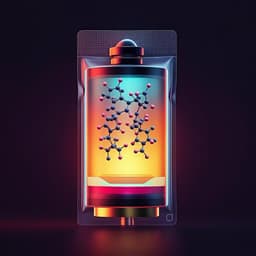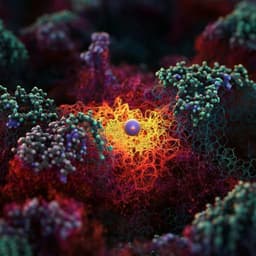
Chemistry
Fluorinated ether electrolyte with controlled solvation structure for high voltage lithium metal batteries
Y. Zhao, T. Zhou, et al.
This innovative research by Yan Zhao, Tianhong Zhou, Timur Ashirov, Mario El Kazzi, Claudia Cancellieri, Lars P. H. Jeurgens, Jang Wook Choi, and Ali Coskun introduces DTDL, a groundbreaking solvent for lithium metal batteries that achieves unprecedented electrochemical stability and lithium-ion solvation, ensuring high performance over numerous cycles. Discover how this could revolutionize battery technology!
~3 min • Beginner • English
Introduction
The study addresses the need for electrolytes that enable high-voltage (>4.0 V vs. Li+/Li) lithium metal batteries (LMBs) while stabilizing the lithium metal anode (LMA). Conventional carbonate electrolytes form stable SEI on graphite but cause severe side reactions and dendrites on Li metal at typical concentrations. Ether-based electrolytes yield flatter Li deposits and high Coulombic efficiency but have poor oxidative stability above ~4 V, limiting their use with high-voltage Ni-rich cathodes. High-concentration electrolytes (HCEs) and localized high-concentration electrolytes (LHCEs) improve compatibility via anion-dominated solvation sheaths and anion-derived SEI/CEI, but suffer from high cost and viscosity and often require inert diluents (HFEs) that do not solvate Li+. There are few fluorinated ethers that both stabilize at high voltage and effectively solvate Li+. The research hypothesis is that a single solvent molecule combining a cyclic fluorinated ether segment (for oxidative stability) with a linear ether segment (for Li+ solvation), and proper spatial arrangement avoiding direct CF3–O bonding, can deliver high-voltage stability while controlling the Li+ solvation structure at conventional salt concentrations. The objective is to design, synthesize, and evaluate 2,2-dimethoxy-4-(trifluoromethyl)-1,3-dioxolane (DTDL) as such a solvent, and demonstrate its electrochemical performance in Li|Cu and Li|NCM811 cells.
Literature Review
Background work highlights: (i) Carbonate electrolytes form stable SEI on graphite but are unstable on Li metal at low salt concentrations, promoting dendrites and short cycle life. (ii) Ether solvents like DME and DOL offer favorable Li plating morphology yet decompose at >4 V, limiting high-voltage applications. (iii) HCEs enable anion-rich solvation and inorganic SEI/CEI formation due to altered HOMO/LUMO of coordinated species, but are costly and viscous. (iv) LHCEs use hydrofluoroethers (HFEs) as inert diluents (e.g., TFEO, BTFE, TTE) to retain solvent-in-salt structures at lower overall concentrations; however, HFEs do not solvate Li+ and require a separate solvating co-solvent that can introduce parasitic reactions. (v) Few fluorinated ether solvents effectively solvate Li+; chain lengthening and fluorination between O atoms in linear ethers improves oxidative stability while maintaining solvation (Bao et al.). This context motivates designing a fluorinated ether that intrinsically balances high anodic stability with sufficient Li+ solvation to form beneficial ion aggregates at normal salt concentrations.
Methodology
Synthesis:
- DTDL (2,2-dimethoxy-4-(trifluoromethyl)-1,3-dioxolane) synthesized via one-pot acid-catalyzed condensation of tetramethyl orthocarbonate (TMOC) and 1,1,1-trifluoro-2,3-propanediol (TFPD) using p-toluenesulfonic acid with Dean-Stark setup; purified by vacuum distillation (yield ~80%).
- Precursors: TMOC prepared by modified literature method; TFPD prepared by hydride reduction of methyl trifluoropyruvate, workup and distillation (yield 44–68%).
Electrolyte preparation:
- 1 M LiFSI-DME and 1 M LiFSI-DTDL: dissolve 187 mg LiFSI in 1 mL solvent; stir 4 h in glovebox.
- 2 M LiFSI-DTDL: dissolve 374 mg LiFSI in 1 mL DTDL; also evaluated 3 M LiFSI-DTDL in supplementary tests.
Characterization:
- NMR (1H, 13C, 19F) for structure confirmation; EI-MS for DTDL. HOMO/LUMO and ESP maps via DFT (B3LYP/6-311++G**).
- Physical properties: viscosity at 25 °C (DTDL 2.4 cP; 1 M LiFSI-DTDL 8.0 cP; DME 0.4 cP; 1 M LiFSI-DME 1.2 cP). Contact angles on Cu and separator.
- Electrochemical stability: LSV in Li||Al half-cells from OCV to 6 V at 5 mV s−1 (and 1 mV s−1 with composite cathode coating; potentiostatic polarization also used). CV on Li||SS and Li||Al.
- Ionic conductivity: EIS in SS||SS blocking cells from −20 to 60 °C (1 M LiFSI-DTDL 1.4 mS cm−1; 1 M LiFSI-DME 21.3 mS cm−1 at 30 °C).
- Li+ transference number (t+): Li||Li symmetric cells under 10 mV polarization with EIS before/after; t+ = 0.75 (1 M LiFSI-DTDL) and 0.39 (1 M LiFSI-DME).
- Morphology: SEM of Li plated on Cu after first cycle and after 20 cycles at 1 mA cm−2, 1 mAh cm−2; cross-sectional SEM; TEM low-dose bright-field for SEI thickness.
- Interfacial chemistry: XPS (surface and depth profiling) of SEI on Li and CEI on NCM811 after cycling; quantification via peak fitting; dual X-ray sources (Al Kα, Cr Kα) and Ar sputtering.
- Spectroscopy for solvation: Raman (focus on FSI− bands and Li–solvent clusters), FTIR, 19F and 7Li NMR with coaxial tube using 1 M LiCl-D2O internal standard to assess Li–FSI coordination.
Electrochemical testing:
- Li|Cu half-cells: CE protocol with 10 formation cycles (0–1.5 V, 0.05 mA), then plating at fixed capacity and stripping to 1 V; tests at 0.5 mA cm−2/0.5 mAh cm−2 and 1 mA cm−2/1 mAh cm−2; also 3 mAh cm−2 Li plating.
- Li|Li symmetric cells: pre-plate 10 mAh cm−2 on Cu, cycle at 0.5 mA cm−2 with 1 mAh cm−2 per half-cycle; monitor voltage hysteresis over time.
- Li|NCM811 full cells: NCM811 cathodes (5 mg cm−2; 8:1:1 NCM:Super-P:PVDF on carbon-coated Al), paired with 20 µm Li (N/P = 4) cycled 2.8–4.3 V at 0.5 C after 0.1 C formation; also high-loading (20 mg cm−2, N/P=1) at 0.3 C with CV hold at 4.3 V to 0.05 C; Al-coated hardware to prevent LiFSI corrosion of stainless steel; electrolyte volume 40 µL (60 µL for high-loading).
- EIS on Li|Cu and Li|Li to track interfacial resistance evolution; flammability tests comparing 1 M LiPF6-EC-DEC vs 2 M LiFSI-DTDL.
Key Findings
- Molecular design and properties:
- DTDL integrates a cyclic fluorinated ether (CF3-substituted dioxolane) and a linear dimethoxy segment, positioning CF3 away from coordinating O atoms to preserve Li+ solvation while lowering HOMO (−7.99 eV) and LUMO (−0.26 eV) vs DME, indicating higher oxidative stability and propensity for anion-first reduction at Li.
- ESP maps show preorganized Li+ binding between a ring O and a linear ether O; CF3 decreases electron density at cyclic O, tuning solvation strength.
- Electrochemical stability and transport:
- LSV (Li||Al): 1 M LiFSI-DTDL stable up to ~5.5 V vs Li/Li+; 1 M LiFSI-DME decomposes at ~4.0 V.
- Ionic conductivity at 30 °C: 1.4 mS cm−1 (1 M LiFSI-DTDL) vs 21.3 mS cm−1 (1 M LiFSI-DME).
- Viscosity at 25 °C: solvent DTDL 2.4 cP; 1 M LiFSI-DTDL 8.0 cP (DME 0.4 cP; 1 M LiFSI-DME 1.2 cP).
- Li+ transference number t+: 0.75 (1 M LiFSI-DTDL) vs 0.39 (1 M LiFSI-DME), favoring dendrite suppression per Sand’s time.
- Wettability (contact angle on Cu): 9° (1 M LiFSI-DTDL) vs 17° (1 M LiFSI-DME); on separator ~19° vs 21°.
- Li plating/stripping morphology and interface:
- After first plating (1 mAh cm−2 at 1 mA cm−2): 1 M LiFSI-DTDL yields dense, dendrite-free, uniform Li coverage; 1 M LiFSI-DME shows bare Cu areas and whiskers.
- After 20 cycles: cross-sections show thin dense Li (12–13 µm) with DTDL vs loose uneven Li (16–23 µm) with DME.
- Average Li grain size: 1.32 µm (1 M DME), 3.54 µm (1 M DTDL), 5.05 µm (2 M DTDL). TEM shows thinner, more homogeneous SEI in 2 M DTDL (17–18 nm) than 1 M DTDL (21–27 nm).
- EIS: DME shows large Rct fluctuation and increase over cycles (porosity and dead Li formation); DTDL remains stable.
- Coulombic efficiency (Li|Cu):
- 1 M LiFSI-DTDL: stable CE 99.2% average after stabilization at 0.5 mA cm−2/0.5 mAh cm−2 over 500 cycles; 98.2% at 1 mA cm−2/1 mAh cm−2 over 300 cycles; 99.0% average for 3 mAh cm−2 over 30 cycles.
- 1 M LiFSI-DME: fluctuating CE including >100% events due to dead Li reconnection and micro shorting.
- Li|Li symmetric cells: DME voltage hysteresis jumps after ~620 h; DTDL maintains stable polarization to ~700 h.
- SEI/CEI chemistry:
- XPS (Li|Cu): Both show LiF and S–F (from FSI−), but DTDL SEI has higher LiF and S–F contents; SEI rich in N and S indicating anion-derived SEI.
- Depth profiles (Li|NCM811): 1 M and 2 M DTDL form uniform, inorganic-rich SEI with consistently high LiF; 1 M LiPF6-EC-DEC SEI is organic-rich at surface and inhomogeneous with depth.
- CEI (NCM811): DTDL-based electrolytes show CF3-containing species (C 1s at 293.3 eV) and LiF-rich F 1s; weaker CF3 signal at 2 M indicates reduced solvent decomposition.
- Full-cell performance (Li|NCM811, 20 µm Li, N/P=4, 5 mg cm−2):
- 1 M LiFSI-DME cannot charge to 4.3 V due to oxidative decomposition.
- 1 M LiPF6-EC-DEC fades rapidly, failing after ~15 cycles due to dendrites/electrolyte consumption.
- 1 M LiFSI-DTDL markedly improves cycling, sustaining slower capacity decay for 108 cycles.
- 2 M LiFSI-DTDL retains 84% of initial capacity after 200 cycles at 0.5 C; voltage profiles remain stable, indicating robust SEI/CEI.
- 3 M LiFSI-DTDL (supplementary) further improves stability vs 2 M.
- Safety: 2 M LiFSI-DTDL shows weak flame vs strong flame for 1 M LiPF6-EC-DEC, attributed to solvent fluorination.
- Solvation structure (Raman/FTIR/NMR):
- 1 M LiFSI-DME: peaks for free FSI− (719 cm−1) and Li–DME coordination (877 cm−1).
- 1 M LiFSI-DTDL: diminished free FSI−; emergence of contact ion pairs (CIP) and aggregates (AGG); at 2 M, dominant AGG peak (~750 cm−1), indicating Li+–FSI− rich clusters at relatively low salt concentrations.
- 19F and 7Li NMR: progressive upfield shifts from 1 M DME → 1 M DTDL → 2 M DTDL, evidencing strengthened Li+–FSI− coordination.
- Result: anion-derived inorganic (LiF-rich) SEI formation prioritized, immobilizing anions and enabling high t+ and stable cycling.
Discussion
The designed fluorinated ether DTDL achieves the dual goals of high oxidative stability and controlled Li+ solvation by coupling a CF3-bearing cyclic ether with a linear ether segment and positioning CF3 to reduce the electron density at one coordinating oxygen. This weakens solvent coordination enough to favor Li+–FSI− contact ion pairs and aggregates even at 1–2 M salt, a solvation environment typically requiring high-concentration or localized high-concentration electrolytes. The anion-dominated solvation sheath lowers the anion LUMO relative to the solvent, promoting preferential FSI− reduction at the Li surface and forming an inorganic, LiF-rich SEI with uniform composition in depth, which is mechanically robust and electronically insulating. This SEI suppresses dendrite formation and mitigates continuous electrolyte consumption, as evidenced by dense Li deposits, stable interfacial impedance, and long-lived Li|Cu and Li|Li cycling with high CE.
On the cathode side, the high anodic stability (to ~5.5 V vs Li/Li+) and LiF-rich CEI enable pairing with high-voltage NCM811. Increasing LiFSI concentration to 2 M enhances the uniformity and inorganic content of interphases on both electrodes, yielding 84% capacity retention after 200 cycles at 0.5 C with a thin (20 µm) Li anode. The combination of high t+ (0.75), improved wetting on Cu, and tuned solvation structure explains the observed suppression of dendrites and improved full-cell stability. These results demonstrate that rational solvent design can replicate the beneficial solvation structures of HCE/LHCE systems within a single-solvent electrolyte at moderate salt concentrations, advancing practical high-voltage LMBs.
Conclusion
This work introduces DTDL, a fluorinated ether solvent that unites high-voltage stability with tailored Li+ solvation in a single molecule. The electrolyte 1–2 M LiFSI in DTDL delivers: (i) anodic stability up to ~5.5 V vs Li/Li+; (ii) high Li+ transference number (0.75); (iii) dense, dendrite-free Li plating with uniform, inorganic-rich (LiF-dominant) SEI; and (iv) robust full-cell cycling with NCM811, retaining 84% capacity after 200 cycles at 0.5 C using a 20 µm Li anode. Spectroscopic analyses reveal that DTDL promotes CIP/AGG Li+–FSI− clusters even at moderate salt concentrations, leading to anion-derived interphases characteristic of HCE/LHCE behavior without diluents. These findings establish fluorinated ether design principles for next-generation high-voltage LMB electrolytes.
Potential future directions include: exploring broader structural variants of fluorinated cyclic–linear ether hybrids to optimize the conductivity–t+ trade-off; investigating other salts and concentrations to fine-tune interphase composition; scaling to pouch cells with lean electrolyte and limited Li; evaluating low-temperature/high-rate performance; and extending to other high-voltage cathode chemistries.
Limitations
- Lower ionic conductivity and higher viscosity relative to DME-based electrolytes at similar salt concentration (e.g., at 30 °C: 1.4 mS cm−1 for 1 M LiFSI-DTDL vs 21.3 mS cm−1 for 1 M LiFSI-DME; viscosities at 25 °C: 8.0 cP vs 1.2 cP), which may impact high-rate performance; performance improvements were achieved partly by increasing salt concentration to 2–3 M.
- Best full-cell stability reported at higher salt concentration (2–3 M), which can increase cost and viscosity.
- Oxidative stability assessments required Al counter electrodes due to LiFSI corrosion of stainless steel at high potential, indicating sensitivity of cell hardware selection with LiFSI-based electrolytes.
Related Publications
Explore these studies to deepen your understanding of the subject.







